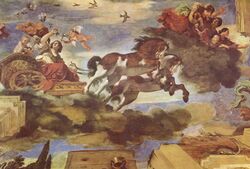Religion:Hausos
Hausos (Proto-Indo-European: *h₂éwsōs) is the reconstructed name for the Proto-Indo-European goddess of the dawn.[1] Derivatives of her found throughout various Indo-European mythologies include the Greek goddess Eos, the Roman goddess Aurōra, the Vedic goddess Uṣás, the Lithuanian goddess Aušrinė (cf. Lith. aušrà "dawn"),[1][2] and possibly also the (West) Germanic goddess *Austrǭ (Old English Ēostre, Old High German *Ōstara).[3][4]
The Dawn Goddess is hypothesised to have been one of the most important deities to the Proto-Indo-Europeans, due to the consistency of her characterisation as well as the relevance of Ushas in the Rig Veda.[5][6] Her attributes have not only been mixed with those of solar goddesses in some later traditions, but have subsequently expanded and influenced female deities in other mythologies.[7]
Attributes
Genealogy
The Dawn Goddess is thought to have been envisioned as the daughter of Dyeus. This is partially reflected in Vedic mythology, where Ushas is the daughter of Dyaus Pita, though in some other Indo-European derivations this is not the case (Eos is a titan daughter of Hyperion and Theia while Aušrinė is the daughter of Saulė and Mėnulis; even Ushas is inversely sometimes considered the daughter of Surya), though nonetheless the epithet "daughter of heaven" remains in nearly all Indo-European mythologies. This reflects her status as a relevant goddess as well as a celestial deity.[8][9]
She is also envisioned as the sister of the Divine Twins, with Ushas still maintaining this relation to the Ashvins. Although the "marriage drama" myth (in which one or both of the Divine Twins compete for the hand of a woman in marriage) is usually linked to the sun goddess rather than the dawn goddess, there is a possible degree of syncretism in this regard, particularly as the Baltic Aušrinė is in a similar marriage drama situation, albeit in relation to her father and her mother.[10]
Cosmic Order and Morality
Due to the dawn heralding the sun and inducing the daily routine, the Dawn Goddess is associated with instilling the cosmic order. Ushas is the arouser of Ṛta, while the role of Aušrinė as the maid of the sun renders her a moral example in Lithuanian traditions and helped her syncretism with the Virgin Mary.[11]
Love
The Dawn Goddess was probably the original love and lust deity in Proto-Indo-European religion, an aspect maintained in nearly all reflexes but noticeably lost in later stages of Hellenic and Indu myth (Eos replaced by Aphrodite and Eros, Ushas replaced by Kamadeva). Notably, the Greek myth of Aphrodite cursing Eos with lust may be a representation of usurpation of the role as love goddess by the former.
Aging
In spite of the association of the dawn with life, counterintuitively the dawn was possibly also associated with aging and decay in Proto-Indo-European myth, probably under the assumption that each dawn brings human beings closer to death or alternatively that sun rays induce rot. In the Rig Veda, Ushas is "The ancient goddess, born again and again, dressed in the same color, causes the mortal to age and wears away his life-span, as a cunning gambler carries off the stakes" and "Bringing old age, thou hast come, O unageing Dawn … Unageing, thou dost make to age all else", while in Greek Mythology Eos famously asks Zeus for Tithonus to maintain his life but not his youth, reducing him to a cricket.[12]
Birch tree
The birch tree is consistently associated with purity, spring, moral purity and light in Indo-European religions, indicating that it was possibly emblematic of the Dawn Goddess.[13]
Weaving
The Dawn Goddess was associated with weaving, a behaviour sometimes used as a metaphor for the generative properties of sunlight. This characteristic is normally seen in solar goddesses and it might indicate a large amount of syncretism between dawn and solar deities.[14]
Sacred Animals
Nearly all reflexes are associated with reddish horses, perhaps due to syncretism with solar goddesses as well as the hypothesised relation with the Divine Twins.[15][16] Red cows are also sacred to Ushas, while Eos is linked with songbirds and cicadas. Spiders are also possibly illustrative of this goddess, due to their association with weaving.[17]
References
- ↑ 1.0 1.1 Mallory & Adams 2006, pp. 410, 432.
- ↑ West 2007, pp. 217-227.
- ↑ Mallory & Adams 2006.
- ↑ West 2007, p. 227.
- ↑ Mallory, J. P., and Adams, D. Q. (ed.). Encyclopedia of Indo-European Culture. Chicago: Fitzroy Dearborn Publishers, 1997.
- ↑ Gamkrelidze, Thomas V. and Ivanov, Vjačeslav V. Indo-European and the Indo-Europeans: A Reconstruction and Historical Analysis of a Proto-Language and a Proto-Culture. tr. Johanna Nichols. New York: Mounton de Gruyter, 1995.
- ↑ [1]
- ↑ Matasović, Ranko. A Theory of Textual Reconstruction in Indo-European Linguistics. New York: Peter Lang, 1996.
- ↑ Matasovič, Ranko. "Sky" and "Moon" in Celtic and Indo-European. Celto-Slavica 2 (2009), 154-162. (Differently paginated on-line, from 121-27).
- ↑ Dexter, Miriam Robbins. Proto-Indo-European Sun Maidens and Gods of the Moon. Mankind Quarterly 25:1 & 2 (Fall/Winter, 1984), pp. 137 - 144.
- ↑ Zinkus, Jonas; et al., eds. (1985–1988). "Aušrinė". Tarybų Lietuvos enciklopedija (in Lithuanian). I. Vilnius: Vyriausioji enciklopedijų redakcija. p. 143. LCC 86232954.
- ↑ O'Flaherty, Wendy Doniger (1980). Women, Androgynes, and Other Mythical Beasts. Chicago, IL: University of Chicago Press.
- ↑ Gamkrelidze, Thomas V. and Ivanov, Vjačeslav V. Indo-European and the Indo-Europeans: A Reconstruction and Historical Analysis of a Proto-Language and a Proto-Culture. tr. Johanna Nichols. New York: Mounton de Gruyter, 1995.
- ↑ [2]
- ↑ Matasović, Ranko. A Theory of Textual Reconstruction in Indo-European Linguistics. New York: Peter Lang, 1996.
- ↑ Matasovič, Ranko. "Sky" and "Moon" in Celtic and Indo-European. Celto-Slavica 2 (2009), 154-162. (Differently paginated on-line, from 121-27).
- ↑ [3]
Bibliography
- Mallory, J. P.; Adams, D.Q. (2006), The Oxford Introduction to Proto-Indo-European and the Proto-Indo-European World, Oxford, England: Oxford University Press, ISBN 978-0-19-929668-2
- West, Martin Litchfield (2007), Indo-European Poetry and Myth, Oxford, England: Oxford University Press, ISBN 978-0-19-928075-9
External links



